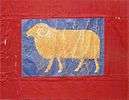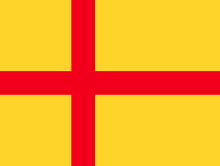Flag of the Faroe Islands
.svg.png)
Swallowtailed version of the flag, unofficial, but popular on the Islands

The original flag now hangs in the church of
FámjinThe flag of the Faroe Islands is an offset cross, which represents Christianity; following, as with other Nordic flags, the tradition set by Dannebrog.[1][2] The flag is called Merkið, which means "the banner" or "the mark". It resembles the flags of neighbouring Norway and Iceland.
Description and symbolism
The design of the flag incorporates a red Nordic cross, which is offset to the left. The red cross is fimbriated azure and is set on a white field. The flag design closely resembles that of the Norwegian flag, with the fimbriated cross. The flag proportion is usually 5:7.
White symbolises the creators of the flag, the foam of the sea and the pure, radiant sky of the Faroe Islands, while the old Faroese blue and red colours are reminiscent of other Scandinavian and Nordic flags; representing the Faroe Islands' bonds with other Nordic countries.[3]
History
The modern Faroese flag was devised in 1919 by Jens Oliver Lisberg and others while they were studying in Copenhagen. The first time Merkið was raised in the Faroe Islands was on 22 June that year in Fámjin on the occasion of a wedding. On 25 April, 1940, the British occupation government approved the flag for use by Faroese vessels, during the tenure of Carl Aage Hilbert as Danish prefect. Britain did not want the same flag as German occupied Denmark to be used. April 25 is still celebrated as Flaggdagur and it is a national holiday. With the Home Rule Act of 23 March, 1948, the flag was recognized by the Danish Government as the national flag of the Faroes. The original flag is displayed in the church of Fámjin in Suðuroy.
|
|
 |
| A picture of the old flag. |
|
 |
| Current Faroese flag. |
|
Popular culture
In the music video for singer Björk's song Declare Independence, the flag of the Faroe Islands (as well as that of Greenland) are featured on the uniforms of those who appear in the video.
References
- ↑ Andrew Evans. Iceland. Bradt. Retrieved 2007-12-31.
Legend states that a red cloth with the white cross simply fell from the sky in the middle of the 13th-century Battle of Valdemar, after which the Danes were victorious. As a badge of divine right, Denmark flew its cross in the other Scandinavian countries it ruled and as each nation gained independence, they incorporated the Christian symbol.
- ↑ "The Australian Flag: Colonial Relic or Contemporary Icon". William Gaunt & Sons. Retrieved 2007-12-31.
The Christian cross, for instance, is one of the oldest and most widely used symbols in the world, and many European countries, such as the United Kingdom, Norway, Sweden, Finland, Denmark, Iceland, Greece and Switzerland, adopted and currently retain the Christian cross on their national flags.
- ↑ Smith/Neubecker: Wappen und Flaggen aller Nationen. München 1981; ISBN 3-87045-183-1
See also
References
 |
Wikimedia Commons has media related to Merkið. |
|
|---|
|
| Sovereign states | | |
|---|
|
States with limited
recognition | |
|---|
|
Dependencies and
other territories | |
|---|
|
| Other entities | |
|---|
|
|---|
|
| National flags | |
|---|
|
| National coats of arms | |
|---|

.svg.png)





